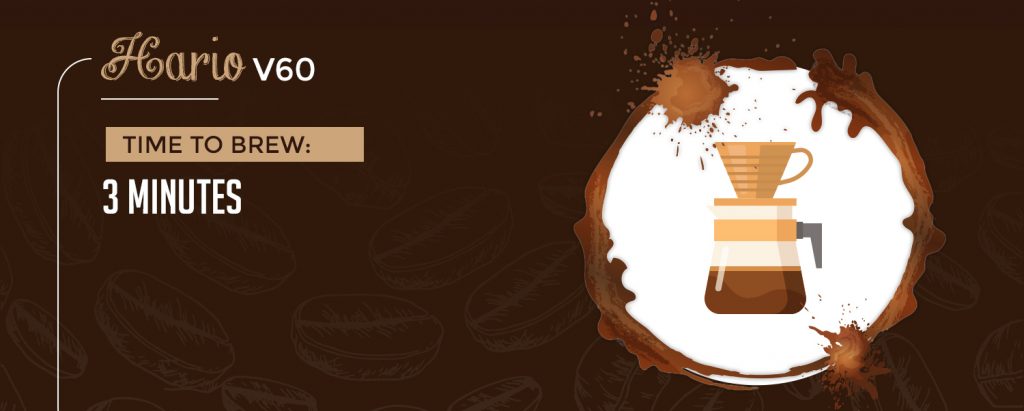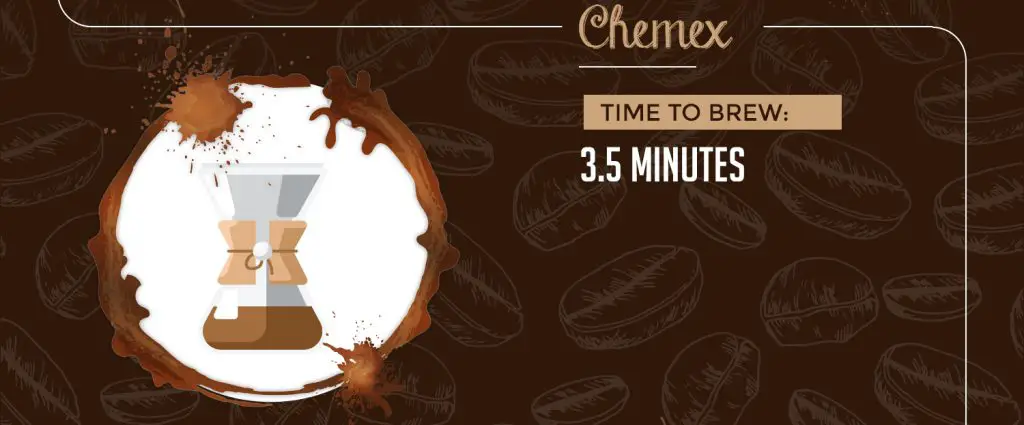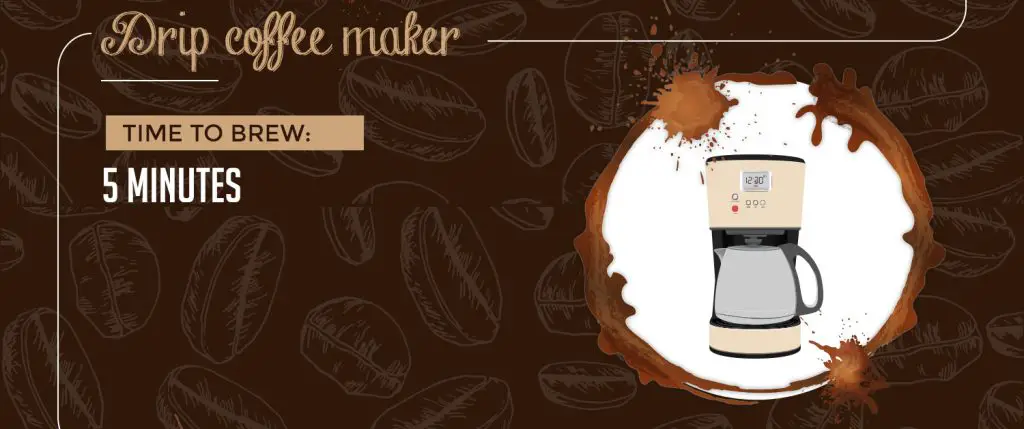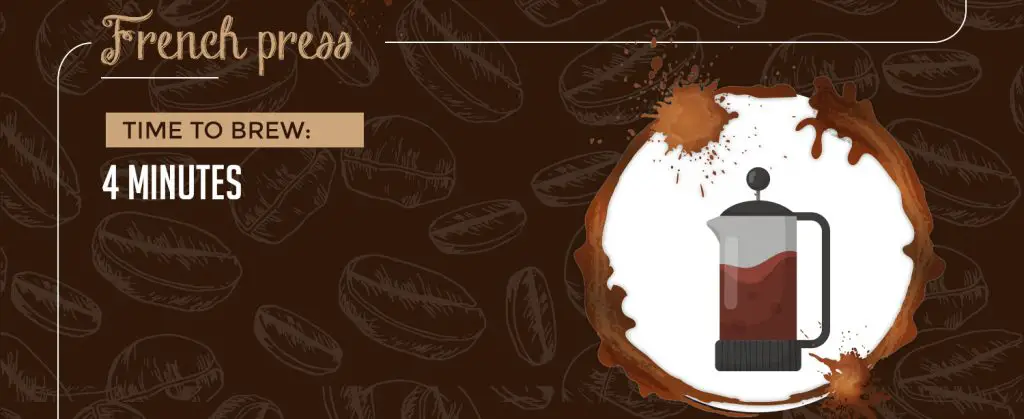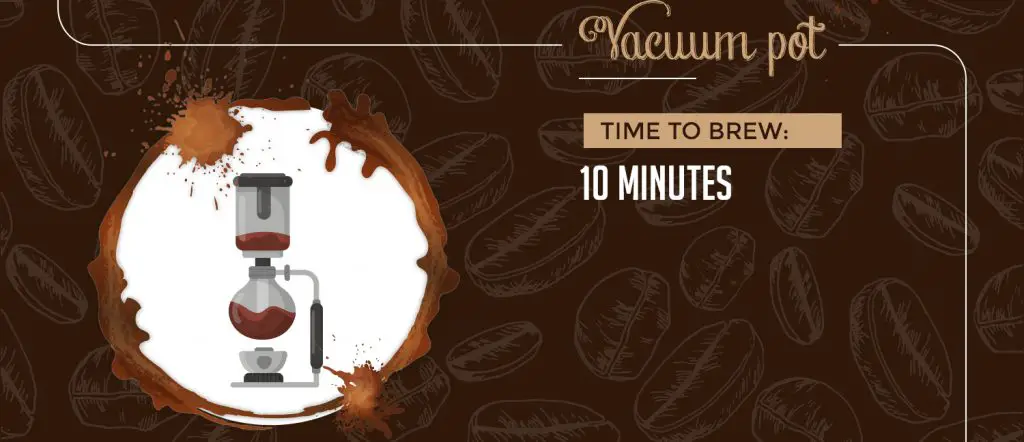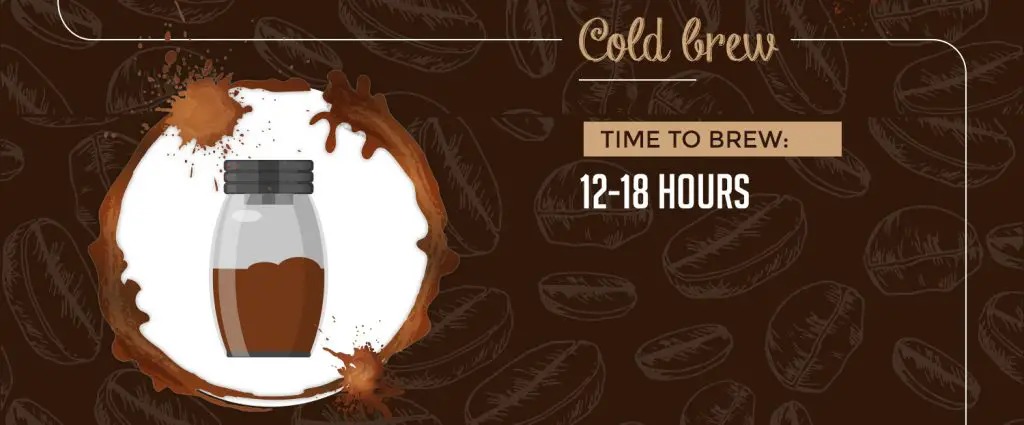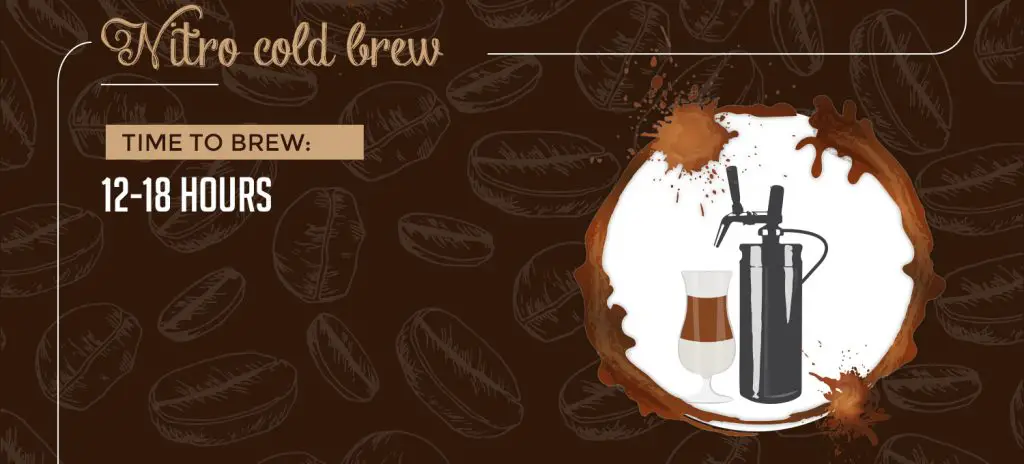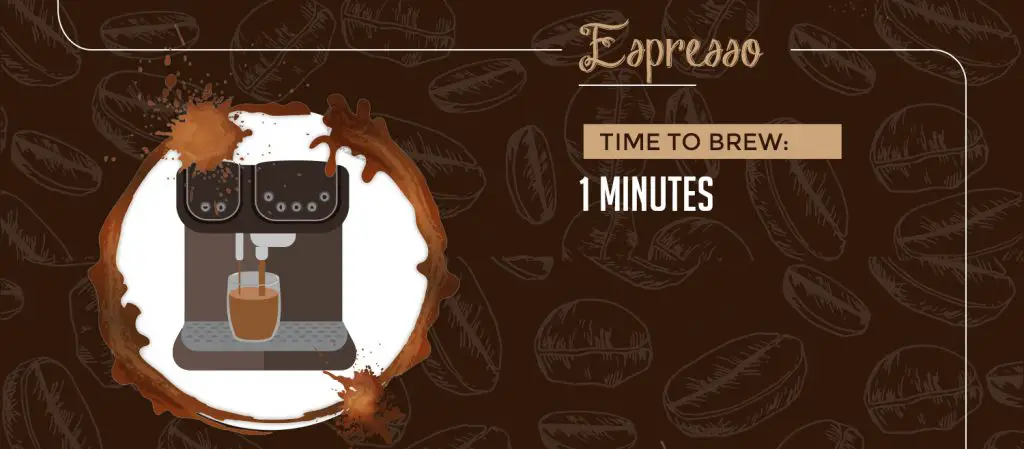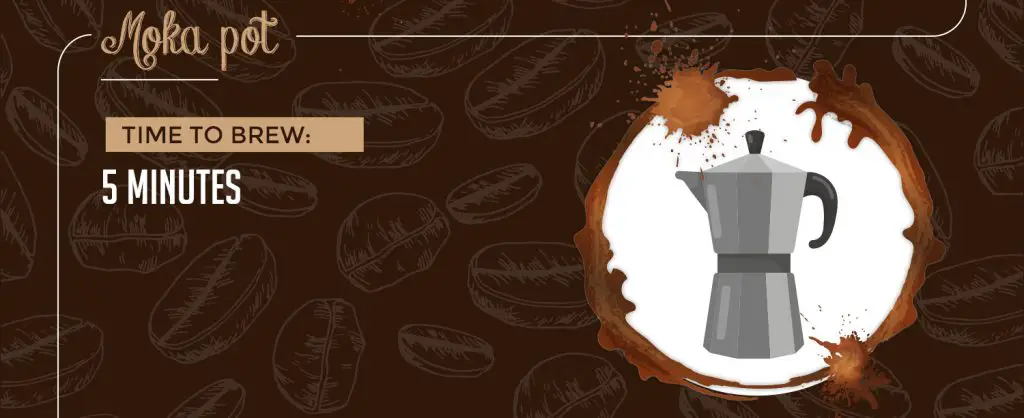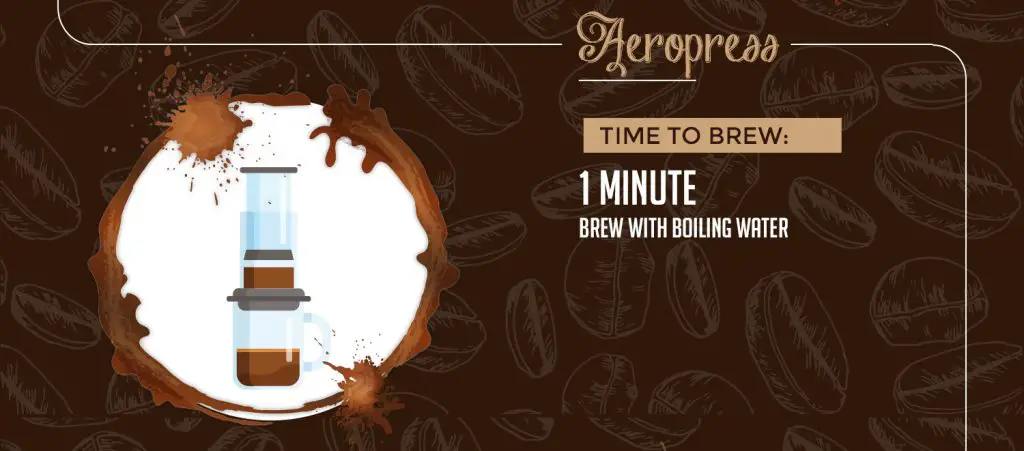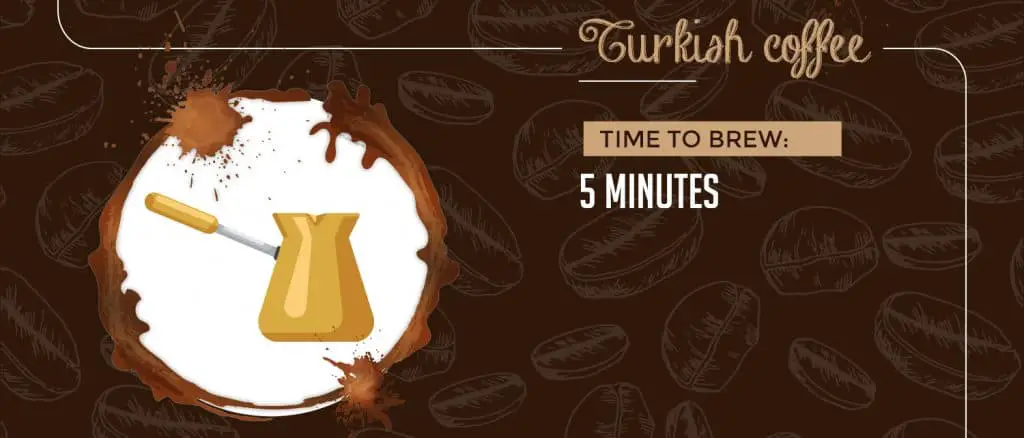There are many different coffee brewing methods and each method has its pros and cons. The beauty of this is that you can use a single kind of bean to produce very different types of drinks depending on how you brew.
Each brew has a distinct flavor and mouthfeel, too. We’ll do our best to give you an overview of each brewing method here, but our best advice would be to actually try some of these methods and see which one you like best.
Broadly speaking, the coffee brewing process can be split into 5 categories:
- Brewing with gravity
- Brewing with immersion or steeping
- Brewing with pressure
- Brewing with boiling water
- Brewing with pods
No matter which way you brew, you’ll need to use good quality coffee! The best coffee machine will make a bad brew if you use stale coffee. So use freshly roasted, freshly ground coffee (click here to find the best coffee beans) and you’ll start noticing a huge difference right away!
Brewing methods that use gravity
Brewing with gravity is essentially pouring water over coffee grounds and letting the water drip through the coffee, through a paper filter (or metal), and into the cup below.
These are classic brewing methods and produce some of the best tasting, brightest coffees. I’ve tried quite a lot of brewing methods and have settled on pour over as my FAVORITE method. That’s why it’s the first on my list, too!
1. Hario V60
The Hario V60 is one of the most popular pour over brewers and for good reason. Even though the design looks quite simple and unassuming, it’s brilliantly designed and functional.
Essentially, it’s just a plastic funnel with a large opening at the bottom and ribs along the sides of the funnel.
The large opening is the genius of the design, as it puts more control in the hand of the pourer. A slow, steady pour will mean a longer, more flavorful extraction.
To get the best results, stick to using the special Hario filters.
It takes a bit of practice to get it right but once you’ve found something that you like it will be unlikely you go back to anything else again.
Time from bean to brew
Assuming you have an electric grinder, you’ll have your beans ready in 20-30 seconds.
The entire brew takes 2-3 minutes from start to finish. Once you have boiling water, you just have to wet the filter, add grounds, bloom, and slowly pour.
Grind required
The ideal grind size is medium-fine. So if you’re using an electric grinder, set it 2 or 3 notches below the middle setting. You can always adjust up or down if necessary.
Taste and mouthfeel
Hario V60 brews tend to be bright and clean. Fruity notes are very prominent (provided you’re using those types of beans) and thanks to the paper filter, it’s incredibly clean with zero grit.
Skill level
There’s a bit of a learning curve, but nothing you can’t master within a few tries.
Good for
Coffee lovers that relish the brewing process as much as they relish the final brew. Hario V60 brewing is an art!
Bad for
Folks who are in a hurry and not interested in a morning ritual for coffee.
Pros
- Inexpensive
- Available in multiple sizes from a single cup to 3 to 4 cups
- Super clean brew
Cons
- Works best with very specific filters
Read more about the Hario V60:
2. Chemex
The Chemex is quite similar to the Hario V60 in that it’s also a pour over brewer, but the brewing method is actually quite different.
Not to mention that the Chemex happens to be gorgeous. It’s a work of art: the glass design, the wooden collar, the leather tie. It’s just iconic.
Chemex is available in 3 cup sizes and above, so it’s great if you brew more than one cup every time. For an individual drinking a single cup, you may find it inconvenient.
Here’s where things get interesting. The Chemex uses a special filter that’s very, very thick. Not only that, but you also have to fold the circular filter into a funnel, so one side will be one layer thick and the other side will be three layers thick.
That means longer extraction times, since the water has to travel through so many more barriers before dripping down.
To compensate for the longer brew time, many people advocate using a slightly coarser grind and more coffee.
Time from bean to brew
The Chemex takes a bit longer to brew than a Hario V60, so you’re looking at 3 to 3.5 minutes. This is assuming you use an electrical grinder and have hot water at the ready!
Grind required
On your electrical grinder, stick to the very middle setting. If you feel the coffee is under-extracted, you can try making the grind one or two notches finer. Alternatively, you can just use a higher ratio of coffee to water.
Taste and mouthfeel
If you thought V60 coffee was clean, Chemex coffee is even cleaner! The brightness and complexity of pour over is definitely going to be there.
Skill level
Pour over is generally a higher-skill brew, but you can get the hang of it within a few tries.
Good for
Pour over enthusiasts who want to buy an icon American brewer. Great if you brew more than 4 cups in one go.
Bad for
Folks who just want to brew a single cup.
Pros
- Gorgeous design, looks like a work of art
- Very clean coffee
Cons
- It’s made of glass, so it’s delicate!
- Filters are expensive
Read more about the Chemex:
3. Electric Drip Coffee Maker
Drip coffee makers are the classic office and diner coffee maker. Dripping is what usually comes to mind when you think of making coffee. It’s just so ubiquitous!
One of the reasons dripping is such a popular way to make coffee is that it makes a brew very similar to pour over, and the whole process is automated.
Essentially, the process is the same: hot water is dripped onto a bed of ground coffee in a filter, and it filters through the coffee and paper filter into a pot below.
Not all drip coffee makers are created equally, though. Some don’t maintain temperature correctly, and some don’t distribute the water evenly.
High end coffee makers have features like a pre-wetting stage that wets the ground coffee to bloom it, then pulses hot water evenly all over the coffee for even extraction.
With these machines, you get what you pay for! See our favorite drip coffee makers here.
Time from bean to brew
Brewing time will depend on how much coffee you are brewing, but you can expect to have 2 to 3 cups ready in 5 minutes.
Many drip coffee makers have automatic brewing so you can set a timer for the coffee maker to brew coffee at a set time, so you can wake up to a cup of coffee.
Grind required
Automatic drip coffee makers need medium ground coffee. You can experiment a little by going a few notches finer.
Taste and mouthfeel
Dripped coffee is much like pour over: clean, bright, and flavorful.
Skill level
Since the machine is doing all the work, you just have to put ground coffee in the filter and start the machine! Dripped coffee is about as easy as it can get to make some good coffee.
Good for
Almost anyone! These machines are incredibly flexible. Drip coffee makers are best for households/settings where you want a pot of coffee at the ready as opposed to just one cup.
Bad for
Almost no one! Everyone can use and enjoy a drip coffee maker, though you may find it difficult to brew just a single cup.
Pros
- Easy to use
- Brews great coffee
- You can set a timer to have a pot ready on demand
Cons
- Difficult to brew just one serving
Read more about drip coffee makers:
4. Kalita Wave
The Kalita Wave is an excellent pour over method that goes head to head against the V60 and the Chemex. Like the V60, the Kalita Wave is a simple little device that you just put on top of your cup, put a filter in, add ground coffee, and start brewing.
However, the key difference between the Kalita Wave and the V60 is that the Kalita Wave has a flat bottom with three small holes in it.
The filters are also flat bottomed to fit in the design.
This means that the speed of the pour is no longer as important a factor as it is in the V60, since the hot water and coffee will mix and slowly drip down.
As a result, the brew is much more forgiving and eliminates the pouring speed variable.
Time from bean to brew
You’re looking at about 30 seconds to bloom and another 3 minutes or so for the brew.
Grind required
Since this is a pour over brew, you want a medium grind. You can go one or two notches finer if you want.
Taste and mouthfeel
Like all drip coffee and pour over coffee, expect a clean cup of coffee with very pronounced flavors.
Skill level
Because the flat bottom eliminates the pouring speed variable, the Wave is a forgiving brewer and you’ll end up with a nice, consistent cup of coffee as long as you can keep the grind, dose, and amount of water consistent.
Good for
Someone who wants to enjoy pour over coffee but does not want to mess around with gooseneck kettles and controlled, slow pours.
Bad for
Coffee artisans that absolutely must use their gooseneck kettles and show off how their pouring finesse makes or breaks their cup of coffee.
Pros
- Easy to use
- Comes in different sizes
- Very convenient
Cons
- There’s some debate as to how effective the three holes actually are
Brewing methods that use immersion
5. French press
French press coffee is in many eyes the classic coffee. It’s been around for a long time and if you’ve come from a household of coffee drinkers chances are your parents have one and so do your grandparents.
Why are french presses so universally loved? Well, for starters, they’re cheap and they brew great coffee. They’re also really easy to use and clean.
French press is a medium-time-consuming brew method. Once you add hot water to coffee grounds, you need to let it steep for 4 minutes before plunging and pouring the coffee out.
You can try 5 or 6 minutes for a stronger brew but I personally prefer 4 minutes as the sweet spot.
It actually takes a little longer for the entire brew as you need to grind the coffee beans, heat up the water (remember the temperature!) and finally steep the coffee.
However, even if you get the grinds perfect, some will still find their way into your cup so you may find the last one or two sips to be a little gritty.
All things said, french press brews really unique and flavorful coffee that is almost universally enjoyed.
Time from bean to brew
You need to steep french press coffee for 4 minutes. Then you can plunge down and enjoy.
Grind required
Of all the hot water brews, french presses need the coarsest grinds. If your grind is too fine, it will pass through the filter and you’ll end up with a gritty, bitter coffee.
Taste and mouthfeel
French press has a full bodied mouthfeel and tends to be very bold. The distinction is noticed best when you compare french press to pour over.
Skill level
Relatively foolproof. There is not much to do except add coffee to water and let it sit!
Good for
Folks who prefer strong, dark brews. The thick mouthfeel is very satisfying, and you can rarely go wrong with french press.
Bad for
Folks who don’t like intense, bold coffee. French press is best suited to darker roasts, so if you’re a light roast person, you may not really enjoy the resulting brew. In that case, pour over or drip would be better.
Pros
- Easy to brew
- Rich flavor
Cons
- Slightly gritty coffee
Read more about the French Press:
- How To Use a French Press
- French press vs pour over coffee
- 9 Best French Press Coffee Makers
- Best Coffee Grinder for French Press
- French Press Cold Brew
- How To Make Iced Coffee With French Press
- Double Brewed Coffee
6. Vacuum Pot
The vacuum pot is a super interesting brewing method that will make you feel like a mad scientist rather than a barista.
Brewing vacuum or siphon coffee is incredibly involved! It’s not the easiest process in the world, either.
Vacuum pot coffee is a mix of immersion and pressure. First, the coffee is steeped in hot water, then sucked into another chamber through vacuum action.
Unless you get the timing right, there’s a good change you will screw it up. But if you can brew it correctly, you may taste the best coffee of your life.
Time from bean to brew
This is a very involved process so you’re looking at 10 minutes for the whole brew.
Grind required
Use a medium grind for best results. If needed, you can adjust a couple of notches up towards a coarser setting.
Taste and mouthfeel
Siphon coffee is very effective at removing any coffee grounds and grit, so the resulting brew is very clean and flavorful.
Skill level
Out of all the ways to make coffee, vacuum is probably the most involved and complicated brewing method.
Good for
Folks who have a mad scientist vibe and want to impress their friends with their extreme coffee knowledge.
Bad for
Anyone who does not want to experiment too much with their coffee and would much rather just sit back, relax, and enjoy a cup.
Pros
- Looks like a science experiment
- Brews good coffee
- Very impressive in front of friends
Cons
- Huge pain to clean
Read more about vacuum pots:
7. Coffee bags
Coffee bags are a slightly improved version of instant coffee. The convenience of instant coffee is that you can have it pretty much anywhere without needing to deal with grinding and brewing. You just mix the granules with hot water and you’ve got coffee.
Terrible coffee, but coffee.
The coffee bag is basically a tea bag but filled with coffee grounds. You steep the bag in hot water for 3 to 4 minutes, and you’ve got a half decent cup of coffee ready to drink.
Here’s the catch: ready made coffee bags won’t give you any control over the grind size or the quality of the coffee grounds.
If you want good tasting coffee, you’ll have to grind the beans yourself and fill them in the bag before you brew.
Time from bean to brew
Ideally you want to steep the coffee grounds for 3 to 4 minutes. So if you’re using ready coffee bags, it’s just 4 minutes from when you add water to having a drink ready in your hand.
Grind required
If you’re making DIY pouches, use a medium-fine grind. Remember to use a material whose pores are smaller than the coffee grounds, otherwise everything will leak out.
Taste and mouthfeel
The taste of bag coffee is meh at best if you use ready sachets, but you can improve the taste by using your own freshly roasted, freshly ground coffee.
Skill level
Very beginner friendly, as there is not much of a process to this brew. You just have to steep and remember to remove the bag in time.
Good for
Emergency situations where you’ve accidentally knocked over your Chemex and broken it and are waiting for a new one to come in the mail. Also good for traveling if you need a couple of shots of coffee in your pocket.
Bad for
Almost any other situation where you have access to some kind of coffee maker.
Pros
- Convenient and portable
- You can get hot water almost anywhere to just throw in a coffee pouch
Cons
- Pre-made bags may have stale coffee
- If you are putting in the effort for using freshly ground coffee, you might as well make cowboy coffee instead
8. Cold brew
Cold brew is the newest and greatest coffee brewing method. It’s been steadily gaining popularity over the past few years and for good reason: it’s just awesome!
It’s actual cold coffee, not those imitations of instant coffee stirred into milk or sugar and ice blended into coffee.
The coffee is actually brewed – but using cold water instead of hot water.
There are plenty of benefits: milder taste, longer caffeine hit, and huge refreshment factor to name a few.
The long waiting period is totally worth it though. You get a really rich, smooth, and flavorful glass of coffee that you can either dilute (depending on the ratio you use) or just add a few ice cubes and a splash of milk to and drink up.
It’s actually the perfect caffeine hit for hot summer days.
Please note that the flavors are going to be very strong and intense – but far from bitter and acidic. If you think it’s too strong, just dilute it with some water, ice, or add a splash of milk.
The way milk slowly swirls into the coffee is also perfect for an Instagram pic!
Oh and if that was not enough, once you’ve brewed the coffee, it will stay drinkable for about 2 weeks, as long as you keep it sealed in an airtight jar or jug.
Time from bean to brew
To make cold brew, you steep coffee grounds in cold water for a long time – usually 12 to 24 hours. Cold water moves much slower than hot water so you need to give it enough time to really extract all the flavors.
A mason jar does this job beautifully.
Grind required
You need to use very coarse coffee grounds for cold brew.
Taste and mouthfeel
Cold brew is incredibly smooth and mellow. It has all the richness of coffee but none of the bitterness. Plus it’s incredibly refreshing when enjoyed ice cold.
Skill level
Fairly easy. Cold brew is just steeping coffee and letting it be, then filtering out the grounds. You can also opt for cold brew bags or special cold brew steeping jugs, but it’s not necessary.
Good for
Making a refreshing drink that you can enjoy at any time! Cold brew is very versatile, so you can drink it straight, dilute it with ice cubes, or even add a splash of milk.
Bad for
I can’t really think of any reason why you should not try cold brew unless you have an aversion to cold beverages.
Pros
- Great taste
- Very refreshing
- One batch can last for up to 10 days
Cons
- Requires a lot of coffee to brew
- Requires a lot of time to brew
Read more about cold brew:
- Cold Brew Coffee Ratio and Proportions
- Is Cold Brew Coffee Less Acidic Than Hot Coffee?
- Best Coffee For Cold Brew: Beans And Pre Ground
- How Long Does Cold Brew Last In The Fridge?
- How Long Should You Steep Cold Brew Coffee?
- Best Cold Brew Filter: Which One To Use
- How To Make Cold Brew Coffee Fast
- French Press Cold Brew
- How To Bottle Cold Brew Coffee
- Is Cold Brew Coffee Less Acidic Than Hot Coffee?
- Hot Bloom Cold Brew: What It Is And How To Make It
- Sous Vide Cold Brew: How To Make A Quick Refreshing Coffee
9. Nitro cold brew
Nitro cold brew is a supercharged version of regular cold brew. You start with regular cold brew and charge it up with nitrogen capsules to create a thick, foamy, frothy drink.
Since you’re using nitrogen instead of carbon dioxide, the foam is much smoother and it does not make the drink extra acidic.
The nitrogen foam adds a lot of smoothness and complexity to the cold brew, and makes for a very enjoyable drink.
Brewing this at home requires some special equipment (a couple of companies have come out with some good home solutions), but you can find it available at many coffee shops. Starbucks’ nitro cold brew happens to be very refreshing.
Time from bean to brew
You need to make cold brew first, which can take between 12 to 24 hours. Then you add nitrogen to the cold brew, which takes another 4 to 5 minutes when you include the set up time.
Grind required
The same as cold brew, very coarse.
Taste and mouthfeel
Very smooth, rich, and creamy. This texture is combined with the mellow, fruity taste of cold brew. It’s amazing!
Skill level
Moderate, but nothing you can’t figure out in a couple of tries. Making cold brew is easy, but the nitro machine has a bit of a learning curve.
Good for
Parties and the occassional smooth drink.
Bad for
Everyday consumption: the cost can add up very quickly and it takes a long time to brew!
Pros
- Amazing taste
- Easily available at many coffee shops
Cons
- The cost of nitro capsules will add up over time
- Store-bought nitro cold brew is not cheap
Read more about nitro cold brew:
Brewing methods that use pressure
10. Espresso
Espresso is like the aristocracy of coffee, and for good reason. It’s an intense, flavorful, and caffeinated shot of pure goodness. Espresso machines have also come a really long way!
The espresso machines of yesteryear were rather simple machines that pressurized water and forced it through a puck of compacted, fine coffee grounds.
Today’s machines are quite complicated. Some machines are simple like those of days past, but others have loads of bells and whistles like built in coffee grinders, milk frothers, dual brewers, and customizable screens.
Essentially, they’re all the same as far as brewing a shot of espresso is concerned. Though you can certainly expect more expensive machines to have more accurate temperature control and ease of use.
The beauty of the espresso machine landscape today is that you can get one for as expensive or as cheap as you want. Check out our espresso machine buying guide here for more information.
However, you can only pull a single or double shot in one go, after each extraction, you’ll need to change the coffee grounds to get a good second cup.
A little hack to brew espresso for two people at once (if your machine only has a single spout) is to brew a double shot and just divide the shot equally into two cups.
There’s a bit of skill involved as far as getting the grind correct, but if you have an automatic espresso machine, they’re about as plug and play as they come. For more control over your brew (if you’re feeling like a barista) you can opt for a manual or semi-automatic machine.
Oh, and espresso machines can be a pain to clean. You have to descale them every 3-6 months depending on how hard your water is, and you’ll also have to wipe down the surfaces every time you brew. I guess it’s a small inconvenience for great coffee.
Time from bean to brew
Espresso machines are actually quite quick. They can heat up water very fast and once the water is at the proper temperature it hardly takes 20-30 seconds to pull a single shot. However, there’s a bit of prep involved in tamping the shot into the portafilter. Still, that’s hardly an extra 20-30 seconds of work.
Grind required
You need very finely ground coffee to brew good espresso. If you pinch the coffee, it should form little clumps.
Taste and mouthfeel
Espresso is thick, full bodied, and has hints of sweetness. It’s also very intense.
Skill level
Varies. Many modern machines take a lot of the guesswork out of pulling a shot. Super automatic espresso machines can do all the work for you and then allow you to tweak certain parameters like grind size and water volume.
You can also opt for manual espresso machines, which require the greatest skill but can provide the best results.
Good for
Anyone! Espresso machines have made espresso incredibly accessible to all coffee lovers.
Bad for
The only drawback of espresso is that the shot is over before you know it. If you’re the kind of person that needs a cup to last for longer, espresso may be disappointing.
Pros
- Espresso shots are quite versatile. Add hot water and it becomes an americano
- Add various amounts of frothed milk and you have a whole variety of frothy, milky beverages like cappuccinos and lattes
Cons
- A good espresso machine can be an expensive up-front investment, but you can also make espresso without an espresso machine
Note: Espresso has a few variants which you can learn more about here:
11. Moka pot or stovetop espresso maker
The moka pot is one of my favorite methods for brewing espresso while traveling. It’s also why moka pots are often known as camping coffee makers or stovetop espresso makers.
Also, compared to espresso machines, they’re really cheap. Pennies on the dollar, actually!
Moka pots and espresso machines are in the same family because they use pressure to brew coffee. In espresso machines, the pressure goes downwards from the top of the machine down through the grounds.
In a moka pot, the pressure goes upwards using steam.
However, the coffee is not quite the same as a shot of espresso. A moka pot is designed to brew a full cup of coffee, not just a single shot. But as far as taste goes, it’s quite intense and very close to an actual espresso.
Depending on the size of your moka pot, you can also brew multiple cups of coffee in a single go.
The bottom chamber holds water, the middle holds coffee grounds, and the top is where brewed coffee comes out.
As you must have seen above, a moka pot requires a grind that’s kind of between an espresso grind (very fine) and a drip grind (medium). This is not an exact science so it’s best to try and find the right grind yourself by adjusting your grinder and seeing which grind tastes better.
Finally, the best thing about the moka pot is that there is nothing complicated about using it. You simply fill the bottom chamber with water, the middle chamber with coffee grounds, place it on the stove and let it do its thing. There’s not much that can go wrong in terms of technique!
Plus it’s cheap so you can enjoy nice, strong coffee on a tight budget.
Time from bean to brew
This is a pretty quick method – within 5 minutes, you’ll have a good brew. Add a couple of minutes for grinding, and a couple of minutes for heating up water, or quicker if you use an electric kettle.
Grind required
Use a fine-medium grind. Not quite as fine as espresso, but not quite as coarse as drip coffee, either.
Taste and mouthfeel
Moka pot coffee tastes a lot like a long black or an espresso. The resulting brew is rich and flavorful, but also a tiny bit gritty like a french press brew.
Skill level
Medium. Some moka pot coffee makers tend to be quite finicky, so you’ll need to monitor the pot on the stove and listen for the sputtering sound to know when it’s done.
Good for
Folks who want an intense cup of coffee but don’t want to drop the cash on an espresso machine. Also great for travel and camping.
Bad for
Brewing multiple cups in one go. Moka pots are usually single cup, though you may be able to find larger ones too.
Pros
- Brews a rich, intense coffee
- Very cheap
- Very portable
Cons
- The pot gets very hot and even if there is a plastic handle, you risk burning yourself
Related
12. Aeropress
The Aeropress (and the smaller Aeropress Go) is an amazing piece of coffee brewing ingenuity. Originally made by a frisbee designer, Aeropress coffee is actually some of the best coffee you can find. I am not joking!
The ingenuity is really in its simplicity. It’s just a plastic tube, with another plastic attachment with a rubber plunger on it. When you put the plunger into the rubber tube, it creates a vacuum and increases pressure, and brews an awesome pressurized coffee.
You can brew espresso-like coffee, or brew a shot and dilute it to make an americano. You can also add milk or frothed milk if you like.
The Aeropress is my go-to method for brewing coffee when traveling, as it’s so compact and does its job so well.
One disadvantage is that you have to use paper filters so there is some waste. If you’re really careful, you can reuse the paper filters by rinsing them and letting them dry out. One paper filter can last you 4-5 cycles, if not more.
Alternatively, you can also pick up a stainless steel filter, but that adds to the overall cost, and paper filters tend to be more effective at removing harmful compounds.
Time from bean to brew
Just around a minute. There are other recipes that call for longer or shorter brews, too.
Grind required
Most Aeropress recipes call for a fine-medium grind, just a little bit coarser than your regular espresso grounds.
Taste and mouthfeel
Aeropress coffee happens to be quite similar in taste and intensity to espresso, though the pressure in Aeropress is nowhere near the pressure in an espresso machine.
Skill level
Fairly straightforward. Basic Aeropress coffee is not difficult to brew, but if you’re willing to experiment, there are lots of cool variations and methods you can try and come up with.
Good for
Easy, flavorful, and cheap brewing for home or travel. The Aeropress can pretty much replace every coffee maker and become your go-to method.
Bad for
I can’t think of any reason you would not want an Aeropress.
Pros
- Very versatile: you can make pretty much anything using an Aeropress
- Inexpensive
- Flavorful, strong brews
Cons
- You need paper filters for best results
Learn how to make Aeropress coffee here
Brewing methods that use boiling water
If you don’t have any equipment on hand except a stove and a pot, you can use these two methods to still make decent coffee.
13. Cowboy coffee
Cowboy coffee is the classic brewing method from when there was no fancy equipment around. It gets the name from being used in camping, when there’s nothing available to brew except a pot and a fire.
It’s super easy to make, too. Just get water to a boil, add coffee grounds, and remove from the heat. Let the whole mixture steep for a few minutes. In this time, the coffee grounds will also settle to the bottom of the pan.
Pour off the coffee and enjoy.
Interestingly, this is the brew method used in coffee cupping where the goal is to taste the pure flavor of the coffee without any adulteration from a brew method.
Time from bean to brew
You’re looking at around 10 to 12 minutes for the whole brew. You have to get the water to a boil, let the coffee steep for 4 minutes, and wait a couple more minutes to get the grounds to settle to the bottom of the pan.
Then you pour it out carefully so that as few grounds as possible get in your cup!
Grind required
Go for a grind size as coarse as french press, or even coarser. Fine grounds will not settle as easily and you’ll get grit in your mouth.
Taste and mouthfeel
You’ll feel like a wild west pioneer when you drink this. There’s no brew method as such involved, so you’ll experience the pure taste of coffee.
It’s also easy to over-brew, though.
Skill level
Medium. Timing is everything here, so you’ll need to be as vigilant for your coffee as you would be for bears around your campsite.
Good for
Camping and times when you don’t have a coffee machine on hand to make coffee.
Bad for
Folks who prefer no-nonsense, convenient brewing. Cowboy coffee is a very involved process!
Pros
- Can be made anytime, anywhere
- Unadulterated coffee taste
Cons
- Messy and easy to burn yourself
14. Turkish coffee
Coffee is originally from the middle east, so it’s no surprise that Turkish Coffee is one of the original forms of coffee brewing. Making Turkish coffee is super old school – you just need a little pot, no fancy filters or anything else.
Just because it’s been around for a while does not mean it’s any less strong – it’s actually quite strong and the jolt of coffee and caffeine is quite awesome.
Making Turkish coffee is quite straightforward, though you’ll need to grind the coffee beans into an extremely fine powder and simmer the brew two to three times over the flame.
The resulting coffee is strong and frothy and if you’re into strong coffees, you’ll love it.
Turkish coffee is super quick to brew because there is a very small quantity of water. It’s strong, slightly powdery (since you don’t filter it) and best paired with Turkish delight or sweet dates.
Time from bean to brew
About 3 minutes. The idea is you need to let the coffee boil over a couple of times.
Grind required
Superfine, even finer than espresso. Not all grinders are capable of such a fine grind.
Taste and mouthfeel
Exotic, rich, and frothy. Adding spices will give a whole new dimension to your coffee.
Skill level
Medium. Turkish coffee is completely brewed by hand so it depends a lot on the skill of the brewer. It’s nothing you can’t master in a couple of tries, though.
Good for
Folks who want an exotic, rich cup of coffee. Turkish coffee is a very social drink and best enjoyed after meals (think dinner parties).
Bad for
Folks who are not fond of gritty coffee.
Pros
- Exotic, rich taste
- No equipment required, though a cezve would help
Cons
- Resulting brew is gritty
- Easy to screw up the brew process
Read more about Turkish coffee:
Brewing methods that use pods
While many people consider pod coffee to be an abomination, there is no denying that it is very convenient and the resulting coffee is not all that bad.
Because of the huge popularity of single serve and pod brewers, we decided to include two of the most popular pod brewers in this list.
15. Keurig
Love it or hate it, there’s no denying that Keurig has gained a solid foothold in the hearts and kitchens of Americans. Keurig machines use special pods called K-cups that brew 6 to 14 ounces of coffee in less than a minute.
The secret to Keurig machines is a secondary water tank that keeps water hot, so when you insert a pod and start the brew, it takes very little time to get the brew going.
The water is forced through a small needle into the pod, where it mixes with the coffee and continues down through the bottom of the pod into the cup below.
Keurig makes a very wide variety of pods with many different varieties and roasts of coffee. You can also get other drinks like hot chocolate and tea.
The biggest selling point for Keurig is the convenience and variety of drinks. You can pick up a sampler pack and have a different kind of coffee every single time.
See our favorite Keurig machines.
Time from bean to brew
There’s no bean here so to speak! From the moment you pop in a pod and press the button, it takes less than a minute to produce a cup of coffee.
Grind required
You don’t need to grind if you buy ready pods. However, you can also opt for reusable K-Cups in which you use your own coffee, in which case you’d want to stick to a medium or medium-fine grind.
Taste and mouthfeel
It really depends on the type of coffee pod you use, but generally, Keurig cups tend to be clean. Some say that the coffee tastes over-extracted and burnt, though.
Skill level
None at all, this is about as simple as it gets.
Good for
Folks who value convenience and speed of brewing above everything else.
Bad for
Anybody who wants to taste “real” coffee. As I mentioned above, many consider Keurig to be an abomination!
Pros
- Large variety of pods available
- Very fast and convenient brewing
Cons
- Not as good as fresh coffee
- Pods are much more expensive than beans
16. Nespresso
Nespresso is another pod based brewer that originally gained popularity in Europe and is slowly becoming ubiquitous in the USA as well.
Nespresso machines excel at making a shot of coffee that’s almost as good as an authentic espresso, except these machines use a pod instead of coffee grounds.
The whole idea is to take the otherwise involved process of pulling an espresso shot and distill it into a simple procedure that takes less than a minute.
Nespresso offers a wide variety of pods so there will be something for every palate. When you shop around for Nespresso machines, remember that there are two types: OriginalLine and VertuoLine.
OriginalLine machines can make two sizes: espresso and lungo.
VertuoLine machines can make four to five sizes from a ristretto all the way to a large cup of Gran Lungo.
See our favorite Nespresso machines
Time from bean to brew
Nespresso machines, like Keurig, are super quick. The machine will be ready to brew in just 30 seconds and it will take another 30 odd seconds to pull the shot.
Grind required
You’ll be using pods, so no grinding is needed! Reusable Nespresso pods are available but the result is just not the same.
Taste and mouthfeel
Nespresso shots taste almost like a proper espresso shot. They’re well-known for their thick, gorgeous crema and rich, thick mouthfeel. The taste will depend on the blend you use but overall you can expect the traditional espresso sweetness and intensity.
Skill level
None at all! It’s plug and play.
Good for
Folks who want to drink espresso but don’t have the patience to grind, tamp, and manually pull the shot.
Bad for
People who want the whole, proper espresso experience and full control over their shot.
Pros
- Super convenient
- Brews a decent shot of espresso
- Machines that have milk frothers make great cappuccinos and lattes
Cons
- Pods are very expensive
Conclusion: is there a “best” way to make coffee?
After discussing these 15 coffee brewing methods, it’s tempting to wonder if there is a best way of making coffee.
The truth is that each method produces very different results, and it depends on what you’re looking for!
Personally, I swear by pour over coffee and I find it to be the most flavorful brew. I love espresso too, but just 1.5 ounces of coffee is not enough for me!
Others swear by french press, or would never touch anything besides cold brew.
There are a couple of ways you can narrow your brewing method choices down, though:
- Cost: Some brewing methods, such as espresso and in some cases drip coffee, require a big upfront investment in equipment. If you are not in a position to spend $200+ on a coffee machine, skip espresso for now. Check out this post to learn about the cheapest way to make coffee.
- Clean vs gritty coffee: Some methods like french press produce a grittier coffee with a thicker mouthfeel, whereas other methods like pour over and drip coffee make a very clean cup.
- Black coffee vs specialty coffee: Most of the coffee brewing methods we’ve talked about make coffee that is best enjoyed black. If you’re into lattes, cappuccinos, and other specialty drinks, then you’d need an espresso machine or Aeropress.
What is your favorite way of brewing coffee? Let us know in the comments!

